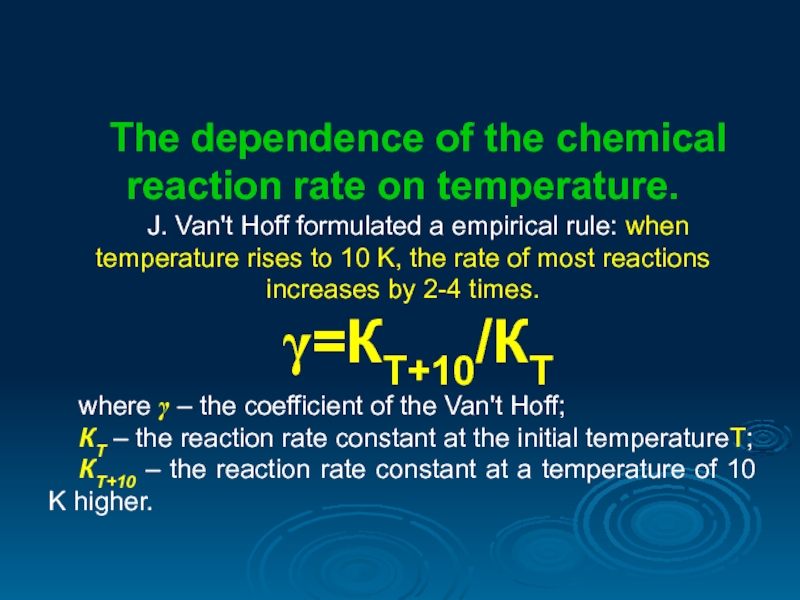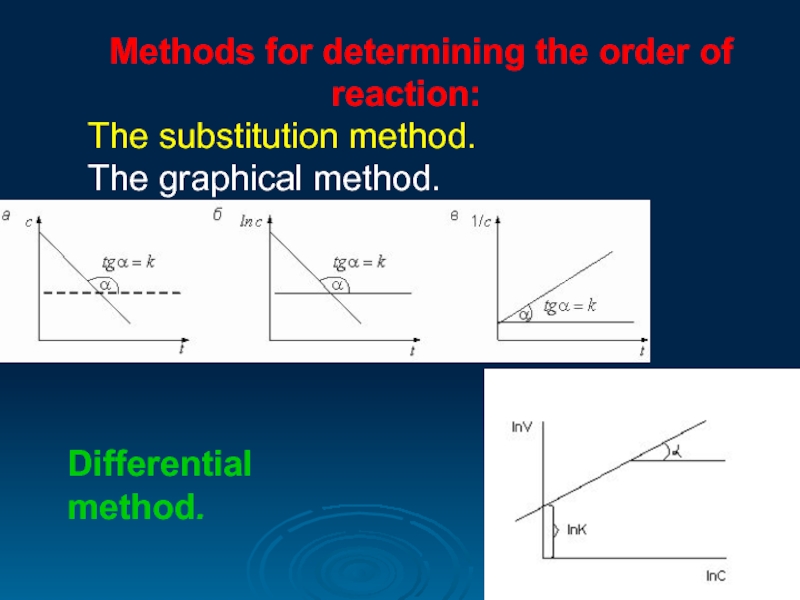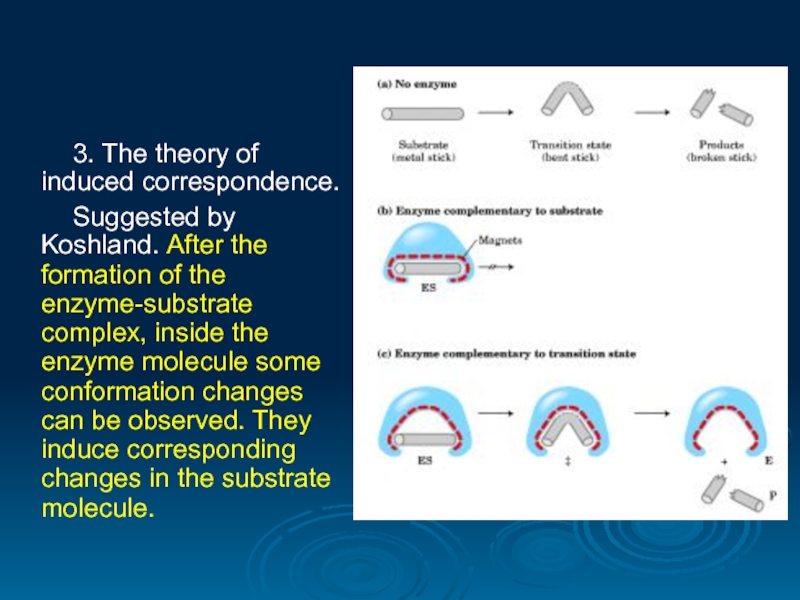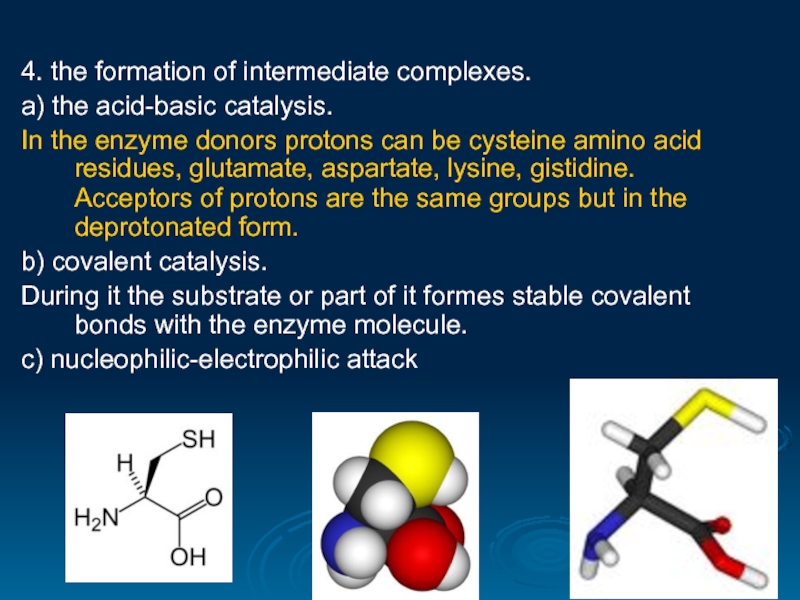- Главная
- Разное
- Дизайн
- Бизнес и предпринимательство
- Аналитика
- Образование
- Развлечения
- Красота и здоровье
- Финансы
- Государство
- Путешествия
- Спорт
- Недвижимость
- Армия
- Графика
- Культурология
- Еда и кулинария
- Лингвистика
- Английский язык
- Астрономия
- Алгебра
- Биология
- География
- Детские презентации
- Информатика
- История
- Литература
- Маркетинг
- Математика
- Медицина
- Менеджмент
- Музыка
- МХК
- Немецкий язык
- ОБЖ
- Обществознание
- Окружающий мир
- Педагогика
- Русский язык
- Технология
- Физика
- Философия
- Химия
- Шаблоны, картинки для презентаций
- Экология
- Экономика
- Юриспруденция
Factors affecting the rate of chemical reaction презентация
Содержание
- 1. Factors affecting the rate of chemical reaction
- 2. Chemical kinetics studies the rate and mechanism of chemical processes. v=mole/L∙sec
- 3. Factors affecting the rate of chemical reaction
- 4. Factors affecting the rate of chemical reaction
- 5. The dependence of the chemical reaction
- 6. THE DEPENDENCE OF THE CHEMICAL REACTION
- 7. The mass action law: at a
- 8. In case of a chemical reaction
- 9. Kinetic chemical reactions classification according to
- 10. Kinetic classification of chemical reactions
- 11. The rate constant. The rate constant
- 12. The period of half-transformation In the
- 13. Methods for determining the order of
- 14. The activation energy. A
- 15. Arrhenius Equation К –
- 16. Catalytic reactions Catalysis is the process of
- 17. Enzymes Enzymes are protein molecules able to
- 18. The active center is a plot of
- 19. Factors affecting the activity of the enzyme
- 20. Specificity of enzymes: highly specific;
- 21. The mechanism of action of enzymes Classic
- 22. The principle of irreversibility of chemical reactions
- 23. Reversible chemical reactions. Equilibrium
- 24. LE CHATELIER'S PRINCIPLE
- 25. LE CHATELIER'S PRINCIPLE 2СО + О2 = 2СО2; ∆Н
- 26. LE CHATELIER'S PRINCIPLE Acid
- 27. The decrease of activation energy is achieved
- 28. 3. The theory of induced
- 29. 4. the formation of intermediate complexes. а)
- 30. PHOTOCHEMICAL REACTIONS Photochemical
- 31. Mechanisms of chemical reactions Atoms, molecules, radicals,
- 32. Mechanisms of chemical reactions Chain reactions. Radical
Слайд 3Factors affecting the rate of chemical reaction
The chemical reaction rate depends
The nature of reacting substances:
Н2 + F2 → 2HF
(in the dark, in cold with the explosion)
Н2 + Cl2 2HCl (in the light)
H2 + I2 2HI (the reaction is reversible)
Слайд 4Factors affecting the rate of chemical reaction
The chemical reaction rate depends
2. The state of the reacting substances.
3. Environment the reaction is proceeding in.
4. The external conditions.
5. Concentration.
Слайд 5
The dependence of the chemical reaction rate on temperature.
J. Van't Hoff
γ=КТ+10/КТ
where γ – the coefficient of the Van't Hoff;
КТ – the reaction rate constant at the initial temperatureТ;
КТ+10 – the reaction rate constant at a temperature of 10 K higher.
Слайд 6
THE DEPENDENCE OF THE CHEMICAL REACTION RATE ON TEMPERATURE.
Where Vt2 –
γ – Van't Hoff’s coefficient ;
t2 – temperature 10°C higher than the initial temperature t1
Слайд 7
The mass action law: at a constant temperature chemical reaction rate
where К – Chemical reaction rate constant, СА and СВ the molar concentrations of reacting substances, х, y, z - stoichiometric coefficients.
К=ν, where СА=СВ=1 mole/L.
Mass action law
Слайд 8
In case of a chemical reaction occurrence at the interface (gas-liquid,
Mass action law
for heterogeneous reactions
where К – Chemical reaction rate constant, S - surface area of the phase separation, СА and СВ the molar concentrations of reacting substances, х, y, z - stoichiometric coefficients.
Слайд 9
Kinetic chemical reactions classification according to the molecularity and order of
Molecularity of reactions is determined by the number of molecules participating in the elementary act of interaction. Most common mono-, bi-and trimolecular reaction.
(1)
The reaction of compound
Oxidation reaction
(2)
(3)
Hydrolysis
Decomposition reaction
Слайд 10
Kinetic classification of chemical reactions
Order reaction is defined as the sum
For example:
1 v=kCCaCO3 n=1, 1st order
v=kCH2CI2 n=2, 2nd order
v=kC2NO CO2 n=3, 3rd order
CH2O=const, v=kCC12H22O11- this is a first order reaction
Слайд 12The period of half-transformation
In the kinetics the notion of the
The period of half-transformation is the time during which reacts half the concentration of initial substances.
Слайд 13
Methods for determining the order of reaction:
The substitution method.
The
Differential
method.
Слайд 14
The activation energy.
A significant increase of the reaction rate as
- fastest molecules whose kinetic energy Ec ≥ 9,7 kJ / mol.
- excited molecules.
The energy required for the conversion of inactive particles in active is called the activation energy Ea kJ/mol.
Слайд 15
Arrhenius Equation
К – the reaction rate constant;
А – a constant value
е – base of the natural logarithm;
R – gas constant;
T – temperature;
Ea – activation energy.
Слайд 16Catalytic reactions
Catalysis is the process of changing the rate of reaction
Reactions taking place with the participation of catalysts called catalytic.
A catalyst is a substance that changes the rate of a chemical reaction, but it is not spent.
Catalysis has specificity:
Слайд 17Enzymes
Enzymes are protein molecules able to accelerate the course of biochemical
Слайд 18The active center is a plot of an enzyme which is
E - enzyme
P - product
S – substrate
I - inhibitor
[ES] – enzyme-substrate
complex
[EP] – enzyme-product
complex
Слайд 19Factors affecting the activity of the enzyme
The concentration of the substrate.
In
= υmax[S]/Km+[S]
Km - Michaelis constant.
A limiting factor of the reaction is the formation of the enzyme-substrate complex.
Km= the substrate concentration at which the reaction rate equals to half of the rate to the maximum.
Слайд 20Specificity of enzymes:
highly specific;
law specific;
nonspecific.
Most of the enzymes are highly
Low specific interact with a group of related substances. Nonspecific change substances of different groups.
trypsin
Слайд 21The mechanism of action of enzymes
Classic catalysts operate due to the
Слайд 22The principle of irreversibility of chemical reactions
Irreversible reactions lead:
to the formation
Zn + 2H2SO4 (k) → ZnSO4 + SO2 ↑+ 2H2O
sedimentation:
Ba(NO3)2 + Na2SO4 → BaSO4 ↓+ 2NaNO3
weak electrolyte:
Na2S + 2HCl → 2NaCl + H2S (in solution)
Слайд 23
Reversible chemical reactions. Equilibrium constant.
Reactions that proceed in opposite directions are
V1=K1CH2CI2; V2=K2CHI2
At the moment of equilibrium V1=V2, means K1CH2CI2 = K2CHI2
Where К1\К2 = CHI2 \ CH2CI2 =Кр
The equilibrium constant is equal to the ratio of the concentration of the reaction product to product concentrations of initial substances, taken in power of stoichiometric coefficient.
For equilibrium processes
0<Кр<
Кр does not dependend on the concentration of substances. Depends on the nature and temperature.
Слайд 24
LE CHATELIER'S PRINCIPLE
Shift of the equilibrium based on the principle
If the system is in a stable equilibrium, external influence upon changing any of the conditions determining the equilibrium position of the system will increase the directions of the process, which weakens the impact of exposure, and the equilibrium will shift in the same direction.
1. The increase in the concentration of initial substances shifts the balance in the direction of increasing the concentration of the reaction products. And Vice versa.
2. Pressure increase shifts the balance in the direction of reducing the volume of the system.
3. Temperature influence: temperature increase shifts the balance in the direction of the process that is accompanied by absorption the heat.
Слайд 25
LE CHATELIER'S PRINCIPLE
2СО + О2 = 2СО2; ∆Н
G - Gibbs energy (j/mol),
Н – enthalpy (j/mol),
S – entropy (j/mol * K)
Increase [O2] leads to the binding O2 and Hb and shift the equilibrium to the right, i.e. in favour of formation HbO2 and Vice versa.
The binding of oxygen by hemoglobin to form oxyhemoglobin occurs according to the equation:
Слайд 26
LE CHATELIER'S PRINCIPLE
Acid - base balance of the body is disturbed
If the reaction results in the formation of gas, insoluble or poorly soluble substance, which would leave the scope of the reaction, the balance shifts to the right.
This reaction is used for preparation of radiopaque drug ВаSO4
Ability to use the principle of Le Chatelier's principle allows to predict changes in the body, caused by external influence.
Слайд 27The decrease of activation energy is achieved by:
1. Orientation substrates.
2. Theory
Слайд 28
3. The theory of induced correspondence.
Suggested by Koshland. After the formation
Слайд 294. the formation of intermediate complexes.
а) the acid-basic catalysis.
In the enzyme
b) covalent catalysis.
During it the substrate or part of it formes stable covalent bonds with the enzyme molecule.
c) nucleophilic-electrophilic attack
Слайд 30
PHOTOCHEMICAL REACTIONS
Photochemical reactions occur with the absorption of light energy
For
6СО2 + 6Н2О
С6Н12О6 + 6О2
Слайд 31Mechanisms of chemical reactions
Atoms, molecules, radicals, or ions may participate in
Reactions occurring between the molecules are called simple : H2 + I2=2HI
2NO + Cl2=2NOCl
Activation energy is 150-450 kJ/mol.
Слайд 32Mechanisms of chemical reactions
Chain reactions. Radical reactions proceed by a chain
H2 + Cl2=2HCl
proceeds by a radical chain mechanism by heating or by lighting light. Due to the absorption of a photon (hν) Cl2 molecule dissociates into free radicals - chlorine atoms:
Сl2 + hν =Сl + * Сl
Atom radical Cl * then reacts with the hydrogen molecule, forming a molecule of HCl and atom radical * N. Last interacts with a molecule of Cl2, HCl and atom forms a radical Cl *, etc.
*Сl + Н2=НСl + *Н
*Н + Сl2= НСl + *Сl and etc.
On each absorbed quantum of light there is formed up to 100,000 molecules НСl





































